Abstract
The population decline of small villages is a very serious problem for our society. This situation is not easy to reverse. The challenge is to generate consensus among the inhabitants of small villages to develop projects that have both a link with social and cultural heritage and the aid of the regional and local authorities. This framework can be successful when it also has the capability to provide new lines of development growing from this initial seed that can attract new inhabitants. In this paper, we present research that follows these requirements. Our proposal is based on a traditional agriculture resource, which is the art of building dry stone walls. We study the case of Tàrbena (642 inhabitants in the province of Alicante, Spain). Stone artifacts are recovered: some of them are still useful for agriculture, and others are cataloged and transformed into a product for cultural tourism. This project is expected to develop local, manual, and specialized work through the development of workshops, crafts, and small businesses. This will provide more income for the municipality and the private sector and more opportunities to attract new inhabitants.
1. Introduction
The depopulation of small villages is a very serious problem for our society to such an extent that it is a matter of concern for the European Union [1]. The consequences of depopulation are both worsening living conditions in the villages and problems that arise in cities as a result of the arrival of new inhabitants. The depopulation of rural areas causes a loss in the basic services offered (health, education, transport, etc.). Young people leave the towns since they cannot find job opportunities, and the aging of the remaining population does not allow economic dynamism to be maintained [2]. Rural depopulation also causes desertification and environmental degradation. This entails a greater risk of fire since the abandonment of the field due to lack of care, and the cattle that no longer graze lead to the growth of bushes and vegetation that burn and hinder the ability to control it.
The depopulation of rural areas also has a severe impact on cities as a result of the constant arrival of new inhabitants. Overpopulation makes it difficult for public administrations to provide services that are essential for the population’s well-being. The prices increase due to the increase in housing demand. This leads to rising rent. The same occurs in the labor market: the wages decrease due to the supply of constantly arriving workers and more, and this may trigger higher unemployment. Finally, there is a drop in the quality of life aggravated by increasing air pollution in cities, which has a detrimental effect on people’s health [3,4].
Both depopulation of rural areas and overpopulation of cities must be overcome in order to meet an equilibrium and preserve the sustainability of the planet. To design an appropriate solution for each case, it will be necessary to carry out an in-depth study to avoid quick and ineffective solutions, as referred to in [5]. The first mistake comes from considering the smart village as the rural version of a smart city, that is to say, promoting the copy of solutions that are suitable for cities without maintaining a serious reflection on such an important topic [6,7]. The danger of this approach is that it leads to implementations that are unworkable and may not be desired or understood by the rural population.
Tourism is generally seen as an essential way of mitigating the effects of depopulation in rural areas [8]. Sun and beach tourists have begun to enter inland areas to discover a different world without crowds, to be in contact with nature, and to enjoy the village atmosphere and local traditions. Visitors can enjoy various activities such as wine tourism, agro-tourism, gastronomy, history, and cultural heritage [9,10,11,12,13,14]. These industries inject economic benefits that complement those that come from rural hotels that have been created from the arrival of new customers [15]. It has been a good thing to avoid the drastic flight of inhabitants from rural areas since new businesses opened and revitalized the business structure of the villages, but it is insufficient in the face of a longer-term solution. It must be highlighted that despite tourism having a beneficial impact that slows the exodus to the big cities, it does not increase the census directly and then cannot increase the basic services or the creation of new housing or other types of facilities for the public good.
Another common idea of the smart village concept is that technological progress if effectively integrated with rural development initiatives, can create new opportunities to increase incomes, provide services, and improves the quality of rural life [16,17]. Farming activities should be recovered but adding diversity to attract businesses and workers. This means that the promotion of local products supported by ICT, such as specializations in agri-food projects and cultural activities, may be considered. Suitable Internet bandwidth is essential for boosting employment in rural areas [18,19]. This may also attract people who have the option to work remotely. The COVID-19 pandemic has shown that it might be safer to work in a healthier and calmer environment than in a big city environment. However, on the one hand, it is clear that rural communities show a lower level of accessibility and openness toward the use of new information technologies than urban communities, and on the other hand, the number of people who have left the cities and have moved to the countryside has not been so important and therefore the repopulation effect has had less impact than expected. Therefore, the commitment to new technologies by itself is not enough. Since we cannot find a simple and complete solution to a complex problem, the best idea is to favor more than one partial solution in the short term, taking advantage of the synergies that exist between them in order to generate viable long-term global solutions.
This paper aims to explore the question of depopulation reversion based on the specific contexts in which rural villages are located. This allows better design making for suitable development strategies linked to real tangible experiences of individuals inhabiting rural space. We study the case of Tàrbena (642 inhabitants), in the province of Alicante, in southeast Spain. Following the introduction, Section 2 analyzes previous works that highlight important keys for the proposal of projects addressing the problem of depopulation. Section 3 presents Tàrbena as a case study. Both the weaknesses (depopulation, aging population, lack of some public services) and the strengths (cultural and environmental heritage, cohesion between inhabitants) are outlined. The preservation, restoration, and reuse of the dry stone artifacts, ancient vestiges of agriculture, is the purpose of the work. Section 4 presents the materials and the methodology that will guide the elaboration of the project, highlighting the agents that have to intervene, the functions that they will carry out as well as the time that they will dedicate and the evaluation of expectations. Section 5 summarizes the interest in the project. It also points out new and enriching experiences gained during the study and presents future research lines and conclusive remarks.
2. Previous Research
New approaches to the depopulation problem have been implemented. In [20], an interesting proposal is presented. It deals with the comparative analysis of two territories: Saint-Camille (529 inhabitants in 2016, Quebec, Canada) and Aras de los Olmos (381 inhabitants, also in 2016, Valencia, Spain), with the theoretical perspective of social innovation. In both cases, a series of common elements have been found that have influenced social, economic, and environmental dynamism. The methodology is the multi-site analysis, which consists in setting a comparison of variables such as demographic changes, resource mobilization by local actors, institutional environment, social organization and participation, and main socioeconomic features of the territories. The comparison offers the opportunity to detect which elements are at the base of the success of these experiences. In conclusion, the authors claim that collaboration between the population and social agents is crucial. In [21], the authors analyze two specific initiatives: the Almadén Mining Park, an amazing UNESCO world heritage site in Ciudad Real (Spain), and the Molina-Alto Tajo District Geopark (province of Guadalajara, Spain), which belongs to UNESCO Global Geoparks. From these examples, the authors demonstrate, as their main objective, that the territorial revival processes take advantage when it initiates by institutions (top-down approach) and then backs up by increasing participation of the local communities (bottom-up approach), encouraged by, among other factors, rural development programs. The Cultural Heritage Agency of The Netherlands commissioned a survey of the approach taken in a number of German, French and British regions to address the problem of depopulation by focusing on heritage. The results of the study have been published on the Cultural Heritage Agency’s website, and ref. [22] is an abridged version of that report. The authors highlight four main functions of the heritage. The heritage serves as a billboard when a local authority attempts to tackle decline by using tourism to provide an economic boost that can attract new residents. Heritage serves as a totem pole when it creates a link between residents and their environment. This may strengthen their will to fight against depopulation by giving it meaning and motivation. The heritage serves as a seedbed when it prompts new activities in an empty emblematic building or area, and the heritage serves as a meeting place when it encourages residents to pull together and launch new activities, restoring the social ties in a village, neighborhood, or region.
These examples reveal some important keys for the proposal of projects that can address the problem of depopulation. Success is more probable when the population is involved, when a social and identity bond exists between people, and when authorities support the projects. Another main feature is when heritage can be “reused” or “recycled” in an imaginative and creative way. For example, historic landscapes can be combined with new ecological values and new economic drivers such as leisure and tourism, an ancient prison can be reused as a historic museum, or an old and obsolete factory can be transformed into a picture gallery. This depends on the concrete case.
3. A Case Study: Tàrbena (Spain)
Tàrbena is a little village situated in the province of Alicante, in a place between mountains but close to the coast, in southeast Spain. Currently, it has 642 inhabitants, and the main income comes from agriculture. The economy has traditionally been the result of the rainfed extensive agriculture (vineyards, almond, carob, olive trees) in the terracing of the slopes of the mountains. People supplement their depleted income with wages from tourism on the Mediterranean coast or exercise liberal professions, or are civil servants outside of Tàrbena even though they reside in Tàrbena.
3.1. Weaknesses
Emigration to the USA began in the mid-nineteenth century due to the Phylloxera plague of the vineyards, which was, at that time, the main source of income. Emigration for political reasons (1940–1950) after the civil war, as well as economic emigration due to the poverty of the people in the post-war period (1950–1960) to Algeria and France, continued to lower agriculture production. Finally, the rural exodus due to the progressive mechanization of agriculture and the difficulty of surviving in a place where there are only smallholdings caused a hard reduction in the population and jeopardized the situation of agriculture, as shown in Figure 1. Despite this sharp decline, depopulation eased in the 1980s due to the arrival of new inhabitants. Most of European origin (currently 36%) were attracted by the advantages of Spain, which had entered the European community. This was also the moment of the development of tourism, with the creation of the first rural houses, some of them with a state subsidy. Meanwhile, the economy has not undergone major changes, agriculture has been slowly declining, and recently, in 2017, Tàrbena, as well as the surrounding villages, experienced a major plant pest caused by Xylella fastidiosa that destroyed all the almond production, which was one of the families’ important source of income. Tourism has also not developed as much as was thought in the 1990s due to the boom in sun and beach tourism and the young population, with more academic training, prefers to go to the city where they have more opportunities.
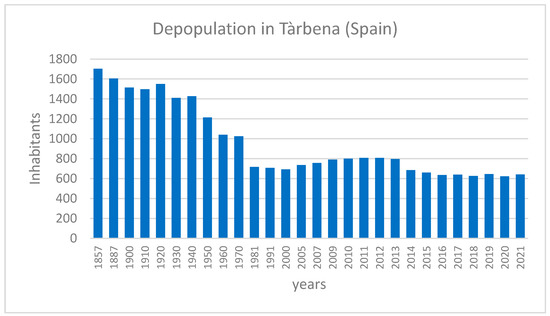
Figure 1.
Depopulation in Tàrbena (Spain) between 1857 and 2021.
Figure 2, Figure 3, Figure 4 and Figure 5 show the age structure of the inhabitants, the unemployment rate, and the economics data of Tàrbena. Figure 2 shows us that the population in Tàrbena is now in a very advanced process of aging; in 2021, the percentage of people aged over 65 years old was 32.7% of the total population which is more than 20 percentage points above what is considered the aging threshold value (12%). The percentage of children under 15 years of age is 7%. Figure 3 shows that the unemployment rate in Tàrbena follows an increasing trend during the pandemic and decreases now. Figure 4 shows that the average income of the population is low due to the very high proportion of retirees who receive a pension of about 800 euros per month. The comparison between the average values of the income of Tàrbena, the province of Alicante, the Valencian community, and Spain shows that in Tàrbena, the lack of young people with high incomes explains the lowest result. The number of economic entities operating in Tàrbena is now about 40, as shown in Figure 5. Some of these companies are hotels (3), rural houses (5), pharmacies (1), bakeries (1), supermarkets (1), carpentry (2), metalwork (1), hairdressing (1), almond breaker (1), oil press (1), photovoltaic installation (1), communications (1), cleaning (2), and construction (2), all them with less than five permanent employees and many with a single employee. Nevertheless, for now, basic health, education, and welfare services have been fully maintained in the village, but communication by road with the important towns on the coast is defective since there is no public transport, only school transport works. There is no more banking service: only two banking entities keep the ATM.

Figure 2.
Population pyramid of Tàrbena in 2021. Blue color for men and pink for women (source: Instituto Nacional de Estadística. Accessed 7 October 2022).
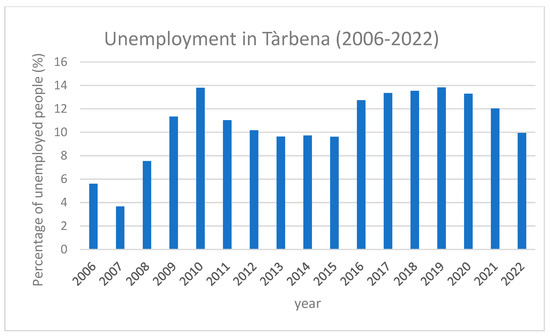
Figure 3.
Unemployment percentages in Tàrbena between 2006 and 2022. (source: Expansión. Datosmacro.com. Accessed 7 October 2022).
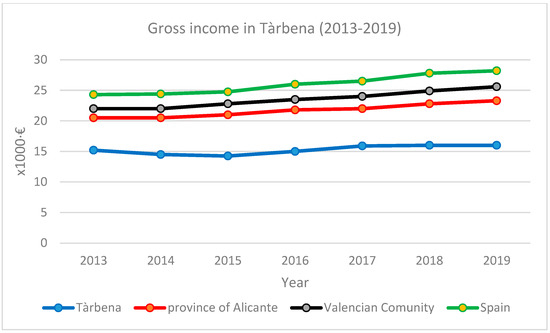
Figure 4.
Comparison of the evolution of gross income in Tàrbena between 2013 and 2019 (source: Instituto Nacional de Estadística).
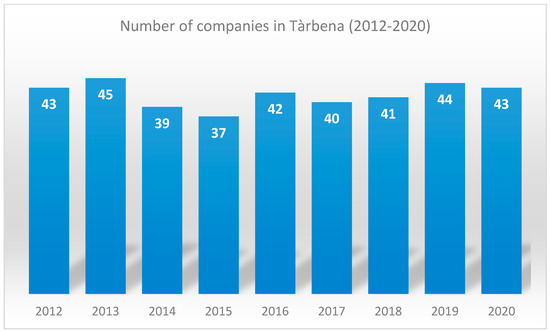
Figure 5.
Companies in Tàrbena between 2012 and 2020 (source: Instituto Nacional de Estadística).
3.2. Strengths
Tàrbena’s greatest wealth is its cultural and environmental heritage, as well as the cohesion between inhabitants coming from their esteem for their signs of identity.
Along with the cultivated areas, the mountain landscape invites hiking and enjoying the great biodiversity of plants, birds, and insects. Also notable is the popular architecture linked to agriculture (roads, terraces, wells, etc. …). Dry stone structures are mainly found in rural areas, on steep land, both in and outside of inhabited areas. History is also very rich. The first signs of settlement are from the Neolithic period, with many cave paintings that are part of the Mediterranean arc protected by UNESCO (1998). In Muslim times (XIth century), the population lived around the castle of Tàrbena, which is the best vestige they left. It is an ‘asset of cultural interest’ (Spanish acronym: BIC). After the expulsion of the Moors, between 1610 and 1615, 17 families coming from the Balearic Islands arrived and repopulated the town, which had been completely deserted. They left their language, their culture, and their gastronomy, which are still very much alive in the population. Since 1997, there has existed a twinning between Tàrbena and Santa Margalida in Majorca because the vast majority of repopulating Majorcans came from this city.
Despite the significant drawbacks it faces, the population of Tàrbena is quite dynamic and resilient. Between 1993 and 2003, the largest restoration project of the parish church occurred. It was a successful project because it brought together all the necessary ingredients: the motivation of the people, the will of the priest, and the support of the municipal and regional authorities. It served at the same time to strengthen links between inhabitants, mobilize public resources, and create a new interesting place for many tourists.
Currently, there are seven non-profit cultural associations that add great value to the life of the town. Since 2016, the cultural association Amics des Museu (15 members) has dealt with the management of the Ethnological Museum of the town and plans together with the town council to develop a project that encompasses agriculture, culture, tourism, education, and training. A similar project that has to do with the freshwater springs is also underway [23]. The project presented in this paper concerns the dry stone structures. In addition to the terraces supported by dry stone walls, many stone constructions such as ditches, aqueducts, wells, refrigerators, and even the Moorish Castle (Sa Caseta des Moros) remain as vestiges of the culture of the past and can be recovered. As follows, Figure 6, Figure 7, Figure 8 and Figure 9 show photos taken by one of the authors of this paper, which represent the landscape of Tàrbena, the slope terracing by dry stone walls for tree cultivation, and some details of the technics and tools for the construction of a dry stone wall at the Ethnological Museum in Tàrbena. In Figure 10, Figure 11, Figure 12, Figure 13, Figure 14 and Figure 15, we show images taken by a member of the association that represent the ancient agricultural resource and the castle we plan to convert into a new cultural tourism resource [24,25,26].
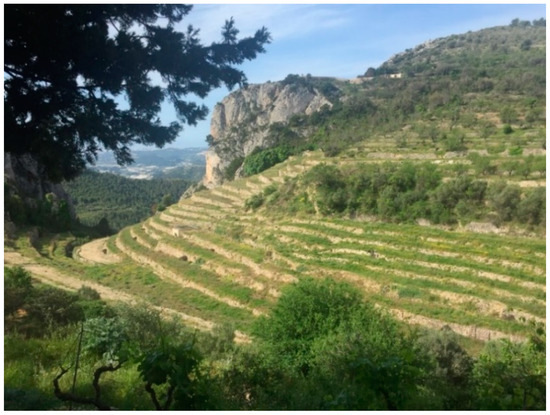
Figure 6.
Landscape of Tàrbena. Dry stone walls.
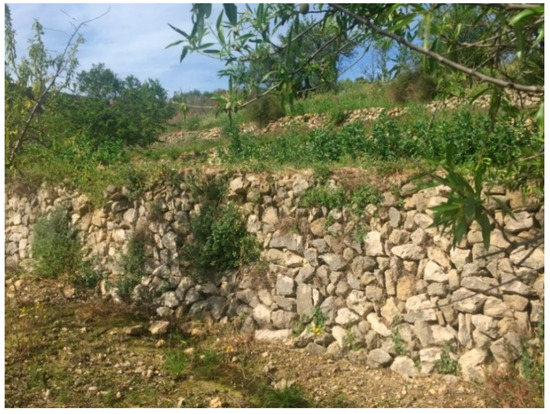
Figure 7.
Slope terracing by dry stone walls for the almond trees cultivation.
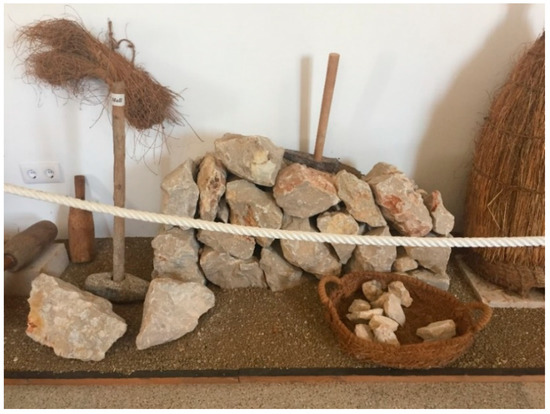
Figure 8.
Detail of the technics and tools for the construction of a dry stone wall. Ethnological Museum, Tàrbena.
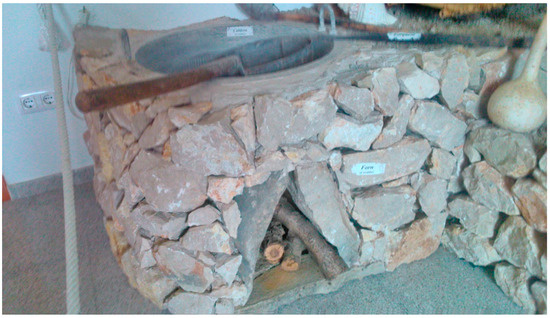
Figure 9.
Stone oven (Forn) to make raisins. Inside the boiler (Caldera) the water is boiled with an alkaline plant and the grapes are introduced through a strainer (Cassa) to be treated. Ethnological Museum, Tàrbena.
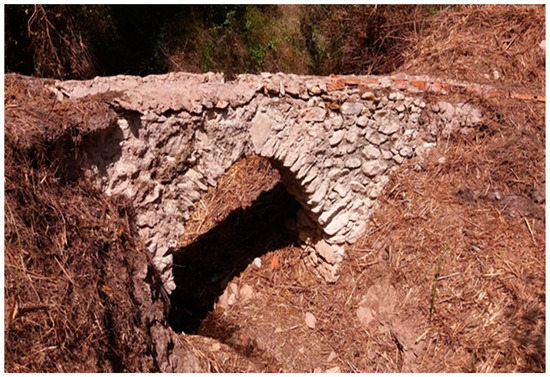
Figure 10.
Aqueduct at Sa Falzia (Tàrbena).
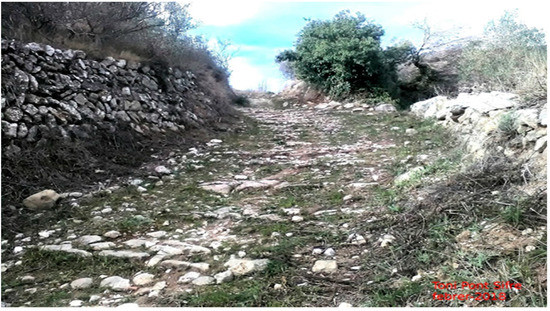
Figure 11.
Steps of the path of Ses Roques (Tàrbena).
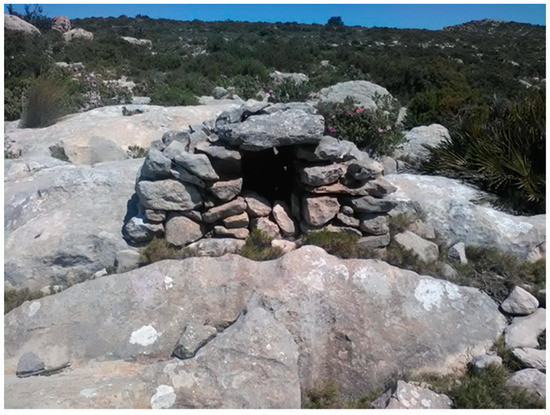
Figure 12.
Well cover at the Pouet de Ses Peres (Tàrbena).
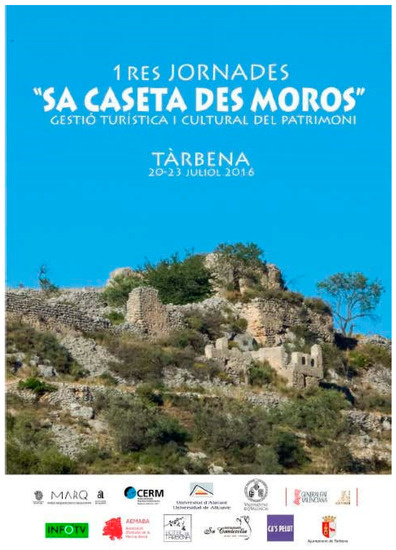
Figure 13.
First workshop “Sa Caseta des Moros”: Tourism and Cultural Heritage Management. Tàrbena, 20–23 July 2016.
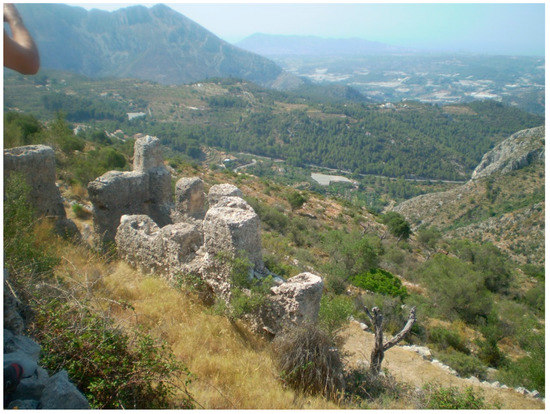
Figure 14.
Remains of the castle battlements (Tàrbena).
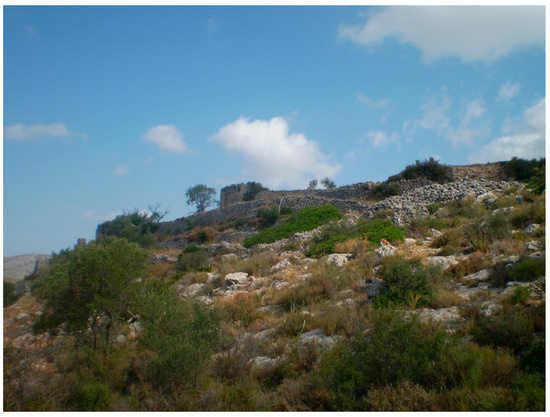
Figure 15.
View of the castle (Tàrbena).
The results of this previous analysis show us that the recognition, restoration, and reuse of dry stone heritage may be an appropriate initial strategy to contribute to the fight against depopulation in Tàrbena. There are several reasons for this choice. The dry stone construction is a characteristic of the town that arouses esteem among its inhabitants due to the agricultural vocation of the town. There is a firm consensus around the idea that it is necessary to preserve and care for cultural heritage to transmit it to future generations. This foundation leads to meeting the goals through social innovation and social entrepreneurship, and this can be a brake on depopulation and also an incentive for new settlers. We summarize the methodology by a scheme; see Figure 16.
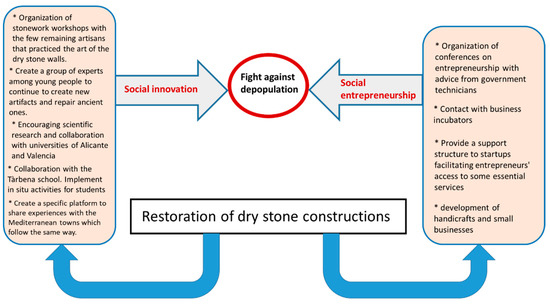
Figure 16.
Scheme of the summarized methodology.
Figure 16 shows that the main goal, which is the fight against depopulation, will be achieved through social innovation and social entrepreneurship. These are born from the recovery of an ancient technique that is dry stone work.
4. The Project
In this section, we first present an overview of the art of building dry stone walls. Then we indicate the materials and methods necessary to execute the project. Finally, we present a schedule that summarizes the main goals, actions, tools, and expected impact of the project.
4.1. The Art of Building Dry Stone Walls: An Overview
The art of building dry stone walls, traditional in rural areas in the Mediterranean basin, was inscribed in November 2018 by UNESCO on its Representative List of the Intangible Cultural Heritage of Humanity. Spain occupies a very prominent place along with Croatia, Cyprus, France, Greece, Italy, Slovenia, and Switzerland. The art of dry stone walling refers to the knowledge related to the construction of stone structures by piling them on top of one another without using any other material to hold them together. The stones are placed based on shape and size. They are joined by the effect of gravity, without using mortar or cement, which allows the passage of water between their interstices, minimizing possible landslides and floods. The constructions also have environmental implications in terms of the prevention of fires and avalanches. They protect from erosion and desertification, improve biodiversity, and create microclimatic conditions suitable for agriculture. Dry stone structures are mainly found in rural areas, on steep land, both in and outside of inhabited areas. They also have given shape to numerous and varied landscapes, creating various forms of useful elements for agriculture and livestock farming [27,28,29,30,31].
We also must outline a very important circumstance, which is the close link between this construction technique and the natural and social environment [32]. This causes a strong identification of this heritage and the inhabitants based on the identity of the places, the materials, and the operators. Indeed, the site of the work is at the same time the place of extract; the stone is the only construction material, and finally, the same person carries out the work from the collection of materials to construction.
More, the knowledge and technique of building in dry stone, as intangible cultural heritage, is also linked to the maintenance of a sustainable organization of rural space. Stones are used in the place, which prevents a possible impact of the constructions on the ecosystem. This non-aggressive architecture has no degradation impact due to abandonment and so does not contaminate the ecological balance. The useful life of stones is much longer than other more artificial materials, and the tools and machinery that are used have a low energy consumption [33].
Several projects are already at work. Namely, in the Balearic Islands (Majorca), a net of routes (91.7 km) through the Tramontana mountains connect the ancient dry stone constructions with other tourist resources such as landscape, history, folklore, and gastronomy. The stages of the GR-221 in the western sector of the Tramuntana travel through the agricultural culture inherited from the Arabs and developed during the Middle Ages, improving the old ditches, the dry stone terraces, and the construction systems of the roads [34].
We also must consider more individual projects that are carried out thanks to rural development programs (RDPs) depending on The European Network for Rural Development (ENRD) which serves as a hub for the exchange of information on how rural development policy, programs, projects, and other initiatives are working in practice and how they can be improved to achieve more [35]. In the database, we can find several projects related to dry stone constructions. We mention as examples the case of two recent projects. The first was in Siggiewi (Malta, 2019–2021). An organic farm used Common Agriculture Policy (CAP) funding to mitigate soil erosion and enhance biodiversity by restoring traditional dry stone walls and planting new olive trees [36]. The second was in Ibiza (Balearic Islands, 2016). A young farmer received RDP support to build stone wall terraces, helping him to improve the farm’s productivity while protecting its soil from erosion. The fundamental benefits of this type of non-productive investment are the maintenance of the landscape and prevention of erosion or loss of soil, which slow down the desertification of the area. Overall, thanks to RDP support, the beneficiary managed to restore his family’s farm and secure an income that allows him to stay in the area [37]. All these considerations encourage us to develop the present project.
4.2. Materials and Methods
The project is divided into four parts: (1) identification and cataloging of all the artifacts, which must be available in a database; (2) restoration of the damaged parts and preservation of the different elements; (3) creation of a tourist product that must be made known, and finally; (4) development of handicrafts and small businesses. These parts are detailed as follows.
- The identification and cataloging of all the artifacts is the first task currently performed. Volunteers, as well as members of the association Amics des Museu, provide measurements, photographs, drawings made by hand, and their locations on the map. Then, the materials are incorporated into an archive, which also provides the coordinates of the artifacts. All the elements are inventoried and informed to request the declaration of cultural interest by the Valencian government (see Figure 17a–e).
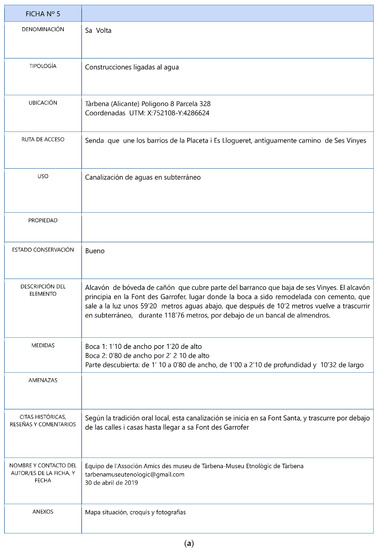
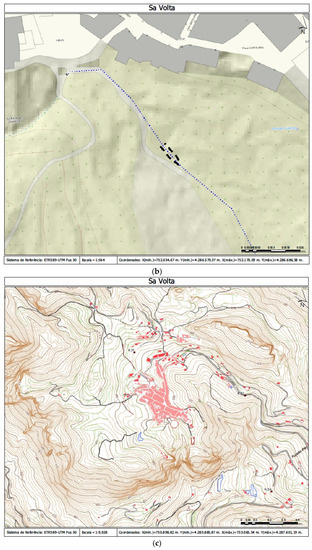
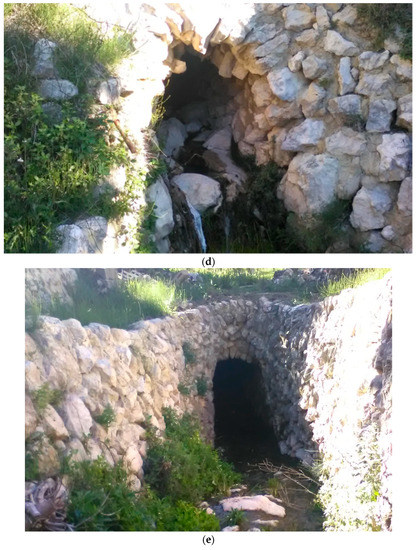
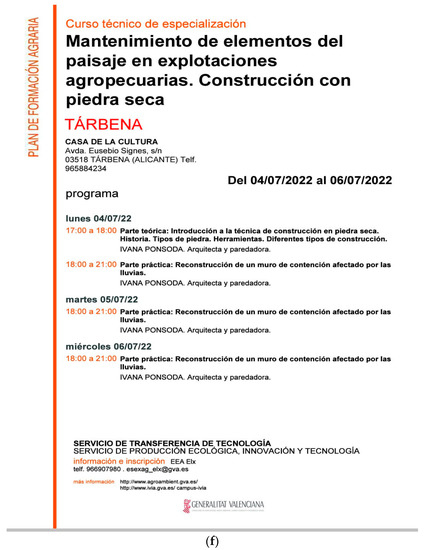 Figure 17. (a): Sa Volta: an example of dry stone construction in Tàrbena; (b,c): locations on the map of Sa Volta; (d,e): images of Sa Volta; (f): program of the theoretical course and practical training workshop on dry stone work organized by local authorities and taught by Ivana Ponsoda, ar-chitect and waller, on 4–6 July 2022, with the participation of 25 persons.
Figure 17. (a): Sa Volta: an example of dry stone construction in Tàrbena; (b,c): locations on the map of Sa Volta; (d,e): images of Sa Volta; (f): program of the theoretical course and practical training workshop on dry stone work organized by local authorities and taught by Ivana Ponsoda, ar-chitect and waller, on 4–6 July 2022, with the participation of 25 persons. - The restoration of the dry stone walls or artifacts is expensive, but it can be assumed in an important proportion by the regional authorities when the Valencian government has granted recognition as an asset of cultural interest. In the meantime, theoretical courses and practical training workshops on dry stone work have been organized by local authorities to start training people who can dedicate themselves in the future to repairing damaged stone elements (see Figure 17f).
- To create a tourist product, a solid supporting infrastructure must be put in place. Accommodation facilities are sufficient in Tàrbena, but there is no public transport, and the banking service is insufficient: only two banking entities keep the ATMs. This represents a serious drawback. The only communication is by road with your own car. The road is in the mountains, with many curves and great scenic beauty. This can be an advantage too. In what refers to telecommunications, 5G mobile phone antennas are available.
- The development of handicrafts and small businesses is the final stage and the consequence of previous long and laborious work. This will be the indicator that economic activity has begun to settle down and that depopulation has slowed down.
In Figure 17a, Sa Volta is presented as an example of dry stone construction, taken from the inventory. The following data is provided: name, typology, location, access route, use, owner, state of conservation as well as an estimate of the threats to which it may be exposed. In addition, a description and measurements of the element and some historical citations, reviews and comments are added. Figure 17f presents the program of the workshop. The title is: Maintenance of landscaping elements on farms. Dry stone construction. The theoretical part focused on an introduction to the dry stone construction technique, history, tools and types of stone, and different types of construction. The practical training was devoted to repair a retaining wall affected by the rains.
4.3. Planning the Project
Information and communication technologies (ICT) will be crucial to the achievement of the project, namely to the first, third, and fourth parts. We need to identify the locations and map the stone artifacts of the past, recreate the past through technological solutions such as augmented reality (AR) [38,39,40,41], and ensure that new generations learn and appreciate this heritage that can provide them with a job and business opportunity and help them stay in their villages instead of migrating to the cities. This planning is designed for a minimum duration of 5 years. During this time, regular meetings will hold with all the actors involved in order to monitor and correct the development of the project if necessary. As follows, Table 1 summarizes the main goals, actions, tools, and expected impact of the project.

Table 1.
Main goals, actions, tools, and expected impact of the project.
As shown in Table 1, an immediate result in what refers to depopulation is not expected since the success of the actions is usually slow. However, tourism, education, ICT, entrepreneurship and cooperation with other towns with similar projects, together with the support of regional and local authorities, can create synergies that result in the advancement of the project and the fulfillment of the objectives.
5. Conclusive Remarks
In the context of sustainable rural development, we have presented a framework project to achieve the reversion of population decline in Tàrbena, a village in southeast Spain, through social innovation and social entrepreneurship. The project is based on the restoration of dry stone constructions. There are many reasons that support this initial choice: the important heritage wealth of the town and the attachment that older people feel for it, the dynamism of the rest of the population, and its ability to organize itself into associations that pursue social and cultural goals. The project is also interesting because it may be a strong complement to the Levantine (macroschematic) art of the painting rocks of Tàrbena, which are on UNESCO’s list of World Heritage Sites.
The main contribution of this research is to provide a framework to meet the desired goal. The steps of the project have been detailed with the main goals, actions, tools, and expected impact. Since it is assumed by the inhabitants and by the local authorities, this project is expected to be successful and provide local, manual and specialized work for the youngest people, as well as higher income for the city council and the private sector such as hotels, crafts and small businesses, and further development of existing communications. This framework can be improved by sharing information, knowledge, and resources with other villages with similar projects in order to create networks of territorial cohesion. Moreover, experiences might be shared with other towns in the Mediterranean area. This research clearly reflects how cultural heritage and sustainable development are linked since recovering dry stone constructions and doing proper management of all the activities that it entails is a powerful tool to stop depopulation, supported by the inhabitants of Tàrbena. We also have to point out new and enriching experiences gained during the study, such as the launch of co-working spaces for digital nomads or the birth of a group of people interested in recovering the health of the soil, excessively punished by the use of pesticides, through a cure that consists on planting oaks in the empty fields after the eradication of the almond trees, to produce truffles that regenerate the soil. These may be important future lines that improve the present research.
We highlight the qualitative excellent results obtained so far in what refers to social innovation because of the progressive involvement of different segments of the population. In what refers to social entrepreneurship, the deployment is now starting, it will surely be slower, and it will also need the help of local and regional governments.
Author Contributions
Conceptualization, M.T.S.-P. and H.M.-M.; methodology, J.J.C.-P.; validation, M.T.S.-P. and H.M.-M.; formal analysis, J.B.-P.; investigation, J.J.C.-P. and J.B.-P.; resources, J.J.C.-P.; writing—original draft preparation, M.T.S.-P.; writing—review and editing, H.M.-M.; supervision, M.T.S.-P.; project administration, M.T.S.-P.; funding acquisition, M.T.S.-P. All authors have read and agreed to the published version of the manuscript.
Funding
This research was funded by the government of Generalitat Valenciana, Spain (Conselleria de Innovación, Universidades, Ciencia y Sociedad Digital). Project AICO 2021-331.
Acknowledgments
We acknowledge the technical support given by the members of the association Amics des Museu Toni Pont and José Francisco Ginart for their pictures and their description of the dry stone artifacts.
Conflicts of Interest
The authors declare no conflict of interest. The funders had no role in the design of the study, in the collection, analyses, or interpretation of data, in the writing of the manuscript, or in the decision to publish the results.
References
- EU Action for Smart Villages, 12 April 2017, European Comission. Available online: https://enrd.ec.europa.eu/news-events/news/eu-action-smart-villages (accessed on 22 July 2022).
- Despotovic, A.; Joksimovic, M.; Kascelan, L.; Jovanovic, M. Causes for depopulation of rural areas in the municipality of Pljevla, December 2015. Agric. For. 2015, 61, 393–407. [Google Scholar] [CrossRef]
- Nkosi, V.; Haman, T.; Naicker, N.; Mathee, A. Overcrowding and health in two impoverished suburbs of Johannesburg, South Africa. BMC Public Health 2019, 19, 1358. [Google Scholar] [CrossRef] [PubMed]
- Kopnina, H.; Washington, H. Discussing why population growth is still ignored or denied. Chin. J. Popul. Resour. Environ. 2016, 14, 133–143. [Google Scholar] [CrossRef]
- Visvizi, A.; Lytras, M.D. It’s Not a Fad: Smart Cities and Smart Villages Research in European and Global Contexts. Sustainability 2018, 10, 2727. [Google Scholar] [CrossRef]
- Gerli, P.; Navio Marco, J.; Whalley, J. What makes a smart village smart? A review of the literature. Transform. Gov. People Process Policy 2022, 16, 292–304. [Google Scholar] [CrossRef]
- Guzal-Dec, D. Intelligent Development of the countryside. The concept of smart villages: Assumptions, possibilities and implementation limitations. Econ. Reg. Stud. 2018, 11, 32–49. [Google Scholar] [CrossRef]
- Cáceres-Feria, R.; Hernández-Ramírez, M.; Ruiz-Ballesteros, E. Depopulation, community-based tourism, and community resilience in southwest Spain. J. Rural Stud. 2021, 88, 108–116. [Google Scholar] [CrossRef]
- Billore, S. Enriching Cultural Experiences from Rural Tourism: Case Studies from Japan. In Tourism Planning and Destination Marketing; Emerald Publishing Limited: Bingley, UK, 2018; pp. 141–159. [Google Scholar] [CrossRef]
- Canovi, M. Resistance to agritourism diversification: An analysis of winery owners’ identities. Tour. Manag. Perspect. 2019, 32, 100566. [Google Scholar] [CrossRef]
- Gaggio, D. The Farmhouse and the Museum: Rural Tuscany as Patrimony. In The Shaping of Tuscany: Landscape and Society between Tradition and Modernity; Cambridge University Press: Cambridge, UK, 2016; pp. 194–237. [Google Scholar] [CrossRef]
- Garau, C. Perspectives on Cultural and Sustainable Rural Tourism in a Smart Region: The Case Study of Marmilla in Sardinia (Italy). Sustainability 2015, 7, 6412–6434. [Google Scholar] [CrossRef]
- Khamung, R. A Study of Cultural Heritage and Sustainable Agriculture Conservation as a Means to Develop Rural Farms as Agritourism Destinations. Silpakorn Univ. J. Soc. Sci. Humanit. Arts 2015, 15, 1–35. Available online: https://so02.tci-thaijo.org/index.php/hasss/article/view/44670 (accessed on 20 July 2022).
- Lu, D.; Liu, Y.; Lai, I.; Yang, L.A. An Important Emotional experience in Sustainable Tourism. Sustainability 2017, 9, 2189. [Google Scholar] [CrossRef]
- Flanigan, S.; Blackstock, K.; Hunter, C. Generating public and private benefits through understanding what drives different types of agritourism. J. Rural Stud. 2015, 41, 129–141. [Google Scholar] [CrossRef]
- Ruiz-Martínez, I.; Esparcia, J. Internet Access in Rural Areas: Brake or Stimulus as Post-COVID-19 Opportunity? Sustainability 2020, 12, 9619. [Google Scholar] [CrossRef]
- Sept, A. Thinking Together Digitalization and Social Innovation in Rural Areas: An Exploration of Rural Digitalization Projects in Germany. Eur. Countrys. 2020, 12, 193–208. [Google Scholar] [CrossRef]
- Rajesh Nimodiya, A.; Sunil Ajankar, S. ICT in Rural Development: Application and Challenges—A Review. Int. J. Sci. Res. Sci. Technol. 2021, 8, 464–472. [Google Scholar] [CrossRef]
- Jayita Pramanik, J.; Sarkar, B.; Kandar, S. Impact of ICT in Rural Development: Perspective of Developing Countries. Am. J. Rural Dev. 2017, 5, 117–120. [Google Scholar] [CrossRef]
- Klein, J.-L.; Pitarch-Garrido, M.-D.; Sales Ten, A.; Martín Cubas, J. El desarrollo local como resultado de un proceso de innovación social en Saint-Camille (Quebec) y Aras de los Olmos (Valencia). Investig. Geográficas 2020, 74, 165–182. [Google Scholar] [CrossRef]
- Ruiz- Pulpón, A.R.; Cañizares-Ruiz, M.C. Enhancing the Territorial Heritage of Declining Rural Areas in Spain: Towards Integrating Top-Down and Bottom-Up Approaches. Land 2020, 9, 216. [Google Scholar] [CrossRef]
- Renes, J.; de Graaf, A.; Hospers, G.J.; Péro, M.; Stegmeijer, E.; Strolenberg, F.; Witsen, P.P. Attract and Connect: Population Decline and the Heritage in Europe, 1st ed.; Rijksdienst voor het Cultureel Erfgoed: Amersfoort, The Netherlands, 2014; ISBN 9789057992285. [Google Scholar]
- Pont, T.; Ginart, J.F. Patrimonio Hidrológico de Tàrbena. Museu Etnològic, 2021. Available online: https://www.bubok.es/.../Patrimonio-hidrologico-de-Tarbena (accessed on 20 July 2022).
- McCombie, P.F.; Morel, J.C.; Garnier, D. Drystone Retaining Walls: Design, Construction and Assessment, 1st ed.; CRC Press & Taylor and Francis Group: Boca Raton, FL, USA, 2019. [Google Scholar]
- Ramos García, F. La interpretación del patrimonio como herramienta básica del turismo cultural: Análisis de varias experiencias. Patrim. Cult. Turismo. Cuad. 2013, 18, 64–81. [Google Scholar]
- Viñals, M.J.; Mayor, M.; Martínez-Sanchis, I.; Alonso-Monasterio, P.; Morant, M. Turismo Sostenible y Patrimonio. Herramientas Para la Puesta en Valor y la Planificación; Universitat Politècnica de València: Valencia, Spain, 2017. [Google Scholar] [CrossRef]
- Visvizi, A.; Lytras, M.D. Rescaling and refocusing smart cities research: From mega cities to smart villages. J. Sci. Technol. Policy Manag. 2018, 9, 134–145. [Google Scholar] [CrossRef]
- Bertolino, A.M.; Corrado, F. Rethinking Terraces and Dry-Stone Walls in the Alps for Sustainable Development: The Case of Mombarone/Alto Eporediese in Piedmont Region (Italy). Sustainability 2021, 13, 12122. [Google Scholar] [CrossRef]
- Cagin, L.; Nicolas, L. Construire en Pierre Sèche, 3rd ed.; Editions Eyrolles: Paris, France, 2022. [Google Scholar]
- Grove, R.; Evans Pim, J.; Serrano, M.; Cidrás, D.; Viles, H.; Sanmartín, P. Pastoral Stone Enclosures as Biological Cultural Heritage: Galician and Cornish Examples of Community Conservation. Land 2020, 9, 9. [Google Scholar] [CrossRef]
- La Moncloa Homepage. Available online: https://www.lamoncloa.gob.es/lang/en/gobierno/news/Paginas/2018/20181128dry-stone.aspx (accessed on 20 July 2022).
- Rossi, G.; Leserri, M. Arquitecturas de Piedra Seca, un levantamiento problemático, EGA. Rev. Exp. Graf. Arquit. 2013, 22, 84–95. [Google Scholar]
- Camacho-Mesa, A. Construcción en Piedra Seca. Guía Práctica de Voluntariado Ambiental; Consejería de Medio Ambiente, Junta de Andalucía: Sevilla, Spain, 2008. [Google Scholar]
- Senderismo. Ruta de Piedra Seca GR 221. Available online: https://caminsdepedra.conselldemallorca.cat/es/ruta-piedra-seca-gr-221 (accessed on 20 July 2022).
- European Network for Rural Development. Available online: https://enrd.ec.europa.eu/about_en (accessed on 20 July 2022).
- Restoring Dry Stone Walls and Planting Olive Trees for Soil Conservation in Malta. European Network for Rural Development. Available online: https://enrd.ec.europa.eu/projects-practice/restoring-dry-stone-walls-and-planting-olive-trees-soil-conservation-malta_en (accessed on 20 July 2022).
- Building Dry Stone Walls in the Balearic Islands. European Network for Rural Development. Available online: https://enrd.ec.europa.eu/projects-practice/building-dry-stone-walls-balearic-islands_en (accessed on 20 July 2022).
- Claudiatom Dieck, M.; Hyungsoo Jung, T. Value of augmented reality at cultural heritage sites: A stakeholder approach. J. Destin. Mark. Manag. 2017, 6, 110–117. [Google Scholar]
- Hincapié, M.; Díaz, C.; Zapata-Cárdenas, M.I.; Rios, H.D.J.T.; Valencia, D.; Güemes-Castorena, D. Augmented reality mobile apps for cultural heritage reactivation. Comput. Electr. Eng. 2021, 93, 107281. [Google Scholar] [CrossRef]
- Perra, C.; Grigoriou, E.; Liotta, A.; Song, W.; Usai, C.; Giusto, D. Augmented reality for cultural heritage education. In Proceedings of the IEEE 9th International Conference on Consumer Electronics (ICCE-Berlin), Berlin, Germany, 8–11 September 2019. [Google Scholar] [CrossRef]
- Carmigniani, J.; Furht, B.; Anisetti, M.; Ceravolo, P.; Damiani, E.; Ivkovic, M. Augmented reality technologies, systems and applications. Multimed. Tools Appl. 2011, 51, 341–377. [Google Scholar] [CrossRef]
Publisher’s Note: MDPI stays neutral with regard to jurisdictional claims in published maps and institutional affiliations. |
© 2022 by the authors. Licensee MDPI, Basel, Switzerland. This article is an open access article distributed under the terms and conditions of the Creative Commons Attribution (CC BY) license (https://creativecommons.org/licenses/by/4.0/).